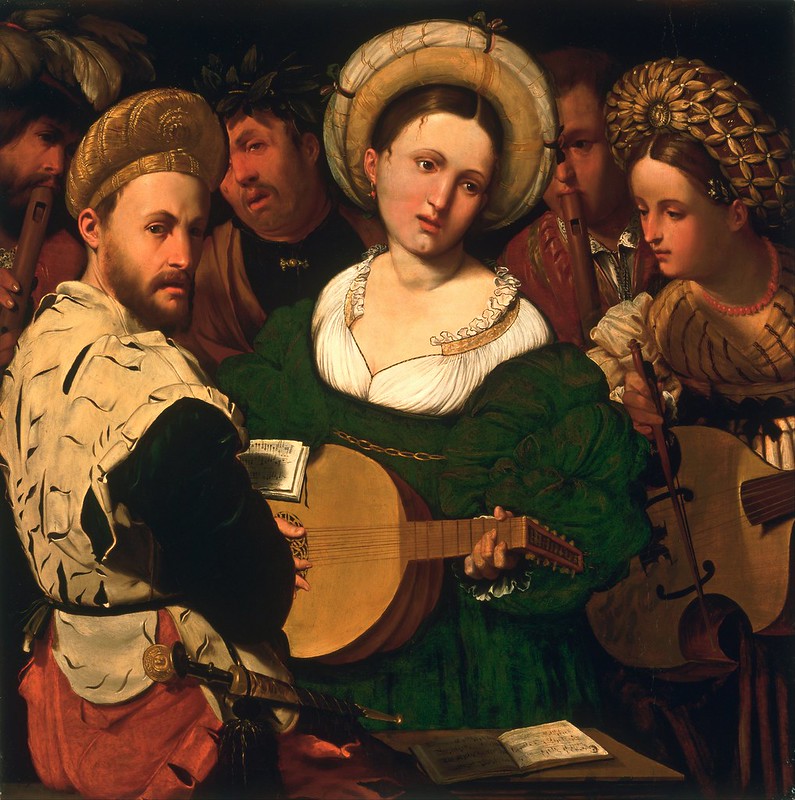Obra de Callisto Piazza (1500-1561), pintor italià (1)
Parlem de Pintura...
Callisto Piazza (Lodi, 1500 - Lodi, 1561) va ser un pintor italià. Membre d’una família de pintors, el 1523 es va traslladar a Brescia on va realitzar la seva primera gran obra en un estil proper al de Romanino i Moretto. En obres posteriors va rebre la influència d’altres mestres com Dosso Dossi i Ludovico Mazzolino, de l’escola de Ferrara, així com de Giovanni Agostino da Lodi. Entre els anys 1526 i 1529 Piazza va viure de forma itinerant tot treballant en poblacions com Val Camonica, Borno, Breno, Esine i Cividate Camuno. El 1529 va tornar a Lodi on va establir un taller amb els seus germans Cesare i Scipione. El 1538, a Crema, es va casar amb Francesca Confalonieri i poc després es va traslladar a Milà on va rebre nombrosos encàrrecs com per exemple la decoració de la capella de San Girolamo de Santa Maria Presso San Celso (1542) o els frescs de la Saletta Negra del Castello Sforzesco. El 1551 va tornar a Lodi on va morir el 1561.
Font: En català: No disponible - En castellano: No disponible - In english: Callisto Piazza (1500-1561) - Altres: Callisto Piazza (1500-1561)
Parlem de Música...
Pietro Lappi (Firenze, c.1575 - Brescia, 1630) va ser un compositor italià. Pocs són els detalls coneguts de la seva vida. Es creu que va ser membre de l’ordre religiós de la Congregazione Fiesolana per més endavant assolir, a partir del 1593 i fins a la seva mort, el càrrec de mestre de capella de la Madonna delle Grazie de Brescia, la ciutat on va morir el 1630.
OBRA:
all except anthologies published in Venice
Sacra omnium solemnitatum vespertina psalmodia cum 3 BVM canticis, 8vv, bc (1600)
Missarum, 8vv, liber I (1601; 2/1607 with bc) [contains 2 motets]
Regis Davidis psalmi ad Vesperas, 5vv, ut hymnus Gloria … 9vv ad lib, regiae virginis deiparae cantica alternis choris, 9–10vv (1605)
La terza con il Te Deum e letanie della Beata Vergine et santi, 8vv (1607)
[5] Missarum, 8–9vv, liber II (1608)
[5] Missarum, 4–6vv, bc (org), liber I (1613)
[10] Sacrae melodiae, 1–6vv, una cum symphoniis e bc (org), liber I (1614, enlarged 2/1621, further enlarged 3/1622)
Canzoni da suonare, a 4–13, libro I, op.9 (1616)
Salmi, 8vv (1616)
Salmi a 3 e 4 chori, bc (org), op.12 (1621; 2/1626 as Compieta a 3 e 4 chori) [includes 1 Mag]
Concerti sacri, 1–7vv, bc, libro II, op.13 (1623)
Messe secondo libro, 4–6vv, op.14 (1624)
Missa et responsorii, op.15 (1625)
Letanie della Beatae Virgine, 4–8vv, bc ad lib, libro II, op.17 (1627)
Salmi concertati, 5vv, bc (org), op.18 (1627)
[30] Hymni per tutto l’anno, 4vv, bc (org) (1628)
Rosario musicale: una messa a 2 cori con terzo coro aggiunto, salmi, litanie, motetti, canzone (1629)
Salmi spezzati, 4vv, bc, op.22 (1630)
5 masses, 1618, 1628;
2 motets, 1612, 1623;
several pieces in Tripartus SS. concentuum fasciculus (Frankfurt, 1621);
3 canzonas, 1608
Motets, D-Bsb, RUS-KA; MS fragments, D-Mbs
OBRA:
all except anthologies published in Venice
Sacra omnium solemnitatum vespertina psalmodia cum 3 BVM canticis, 8vv, bc (1600)
Missarum, 8vv, liber I (1601; 2/1607 with bc) [contains 2 motets]
Regis Davidis psalmi ad Vesperas, 5vv, ut hymnus Gloria … 9vv ad lib, regiae virginis deiparae cantica alternis choris, 9–10vv (1605)
La terza con il Te Deum e letanie della Beata Vergine et santi, 8vv (1607)
[5] Missarum, 8–9vv, liber II (1608)
[5] Missarum, 4–6vv, bc (org), liber I (1613)
[10] Sacrae melodiae, 1–6vv, una cum symphoniis e bc (org), liber I (1614, enlarged 2/1621, further enlarged 3/1622)
Canzoni da suonare, a 4–13, libro I, op.9 (1616)
Salmi, 8vv (1616)
Salmi a 3 e 4 chori, bc (org), op.12 (1621; 2/1626 as Compieta a 3 e 4 chori) [includes 1 Mag]
Concerti sacri, 1–7vv, bc, libro II, op.13 (1623)
Messe secondo libro, 4–6vv, op.14 (1624)
Missa et responsorii, op.15 (1625)
Letanie della Beatae Virgine, 4–8vv, bc ad lib, libro II, op.17 (1627)
Salmi concertati, 5vv, bc (org), op.18 (1627)
[30] Hymni per tutto l’anno, 4vv, bc (org) (1628)
Rosario musicale: una messa a 2 cori con terzo coro aggiunto, salmi, litanie, motetti, canzone (1629)
Salmi spezzati, 4vv, bc, op.22 (1630)
5 masses, 1618, 1628;
2 motets, 1612, 1623;
several pieces in Tripartus SS. concentuum fasciculus (Frankfurt, 1621);
3 canzonas, 1608
Motets, D-Bsb, RUS-KA; MS fragments, D-Mbs
Parlem en veu pròpia o en veu d'altri...
GROVE MUSIC ONLINE (source/font: aquí)
Gaudiu i compartiu!
Informació addicional...
AMAZON: LAPPI, P. - Ceremonial Music of Brescia
IMSLP: Pietro Lappi (c.1575-c.1630)
SPOTIFY: LAPPI, P. - Ceremonial Music of Brescia

Tant si us ha agradat, com si no, opineu, és lliure i fàcil!

Tant si us ha agradat, com si no, opineu, és lliure i fàcil!
